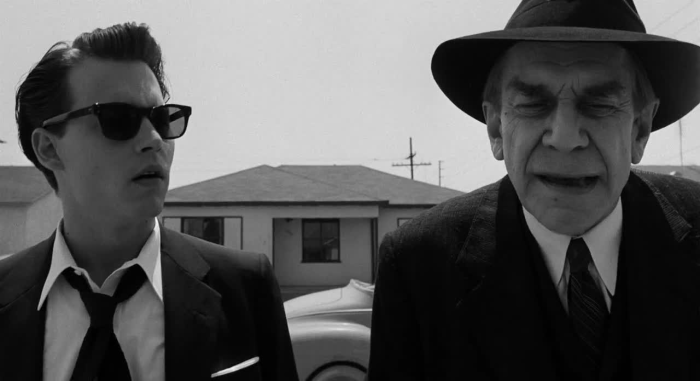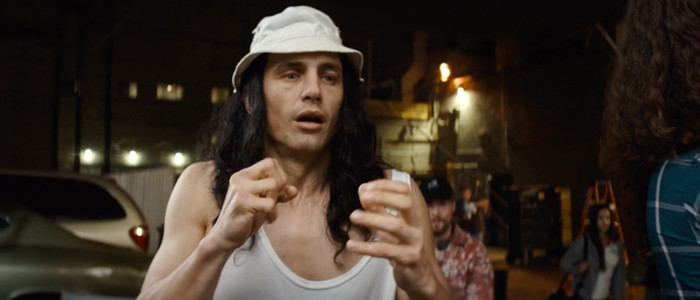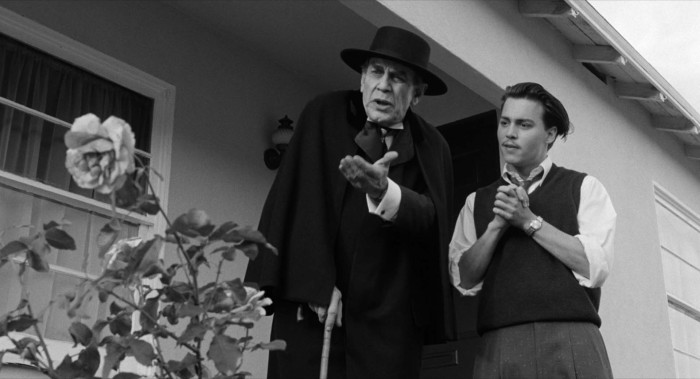'The Disaster Artist' And Tim Burton's 'Ed Wood' Are Perfectly Imperfect Companion Pieces
Ed Wood and the Tim Burton film that bears his name were years before their time. The director who's known now as one of the worst filmmakers ever (if not the worst) only gained that dubious status via the truly esteemed Golden Turkey Awards, two years after his death in 1978. He was immortalized in Burton's best film, the 1994 biopic Ed Wood, which documented Wood's ascent (or descent, if you like) into becoming a director while allying himself with unlikely friend Bela Lugosi, the once-fearsome Dracula actor, in the final years of his life. Now, cults surround movies of poor quality like moths to a flame; back in the 1950s, Wood wasn't able to amass a larger fanbase.
In the 21st century, we do not have Ed Wood, a huckster of a filmmaker who used every means possible to make his often baffling, terribly acted films with meager budgets. The closest analogue is Tommy Wiseau, the writer/producer/director/star of 2003's The Room, a cult film whose appeal may be hard to describe if you haven't already experienced its odd, antagonistic charms. For the last few years, Wiseau has received the same kind of cultish treatment Wood only received in death. Wiseau is thought of as one of the worst filmmakers ever, and a large cult has sprung up around The Room, having inspired a book called The Disaster Artist, which has now led to the film of the same name, directed by and starring James Franco in the role of the mysterious, maddening filmmaker himself.
Tommy Wiseau's origins are a mystery to his best friend, Greg Sestero (who wrote the book, and is played in the film by Dave Franco, James' brother), as depicted throughout the film. The three key questions about Tommy that Greg and others ask — how old is he? Where is he really from? And how does he have the funds to pay for a multi-million-dollar independent film production? — remain a mystery. Greg and the rest of the cast and crew of The Room can guess at answers for the first two questions, but the last one remains an inexplicable mystery. (The film's script supervisor, played by Seth Rogen, is shocked when he successfully deposits one of Wiseau's checks at the bank, confidentially told by the teller that Wiseau's account is "a bottomless pit.") While the making of The Room serves as the meat of the story — The Disaster Artist is largely a very good film, and the second-act sequences in which we see how this very bad sausage was made are its high points — the core of the story is the manipulative, co-dependent relationship between Wiseau and Sestero.
In this respect, The Disaster Artist feels like a refracted mirror image of Ed Wood. In the latter film, Wood idolizes Lugosi (Martin Landau, in an Oscar-winning performance) for his older work in iconic horror films of the 1930s, and is thus taken aback to learn that his hero is a morphine user whose addiction spirals out so much that he eventually suffers through massive withdrawal in a local rehab center. Yet Wood, as much as he wants to help Lugosi, also wants to use him, the older man's presence often being enough to bankroll and promote films like Glen or Glenda? and Plan 9 From Outer Space. He respects Lugosi enough to write him intense monologues that befit the legendary figure's outsized talents, but he's still using the horror star for his own ends, just as Lugosi seems to briefly thrive on Wood's passionate fandom.
Neither Tommy Wiseau nor Greg Sestero, when we meet them in a San Francisco acting class in 1998, are quite as driven as Wood or Lugosi. The 19-year old Sestero wants badly to be an actor, but wilts under the spotlight, and thus instantly admires Wiseau (who, every time Greg asks his age, says "I'm your age") for his unadulterated passion and willingness to dive headlong into any acting exercise. The two bond further over acting and their shared desire to be stars, even though Wiseau's awareness of other actors or films seems...vague, at best. (Within the context of the film, Sestero introduces Wiseau to James Dean, over 40 years after Rebel Without a Cause.) Soon, Sestero gives Wiseau the idea to make a movie on his own the former because he doesn't pop next to other young male actors, the latter because...well, he's Tommy Wiseau.
For the uninitiated, both in real life and in Franco's very funny performance, Tommy Wiseau is a long-haired man who prefers to wear sunglasses and has an indeterminate but prominent Eastern European-sounding accent that results in very broken English. (In one audition, when Wiseau is encouraged to "lose the accent," he clips each word he says even further, making the entire thing incomprehensible.) Thus, it's not exactly surprising that Wiseau struggled to get a career or become a star; that would be true even if he wasn't abrasive, alienating, and selfish. Within the context of the film, there is a sense that him making The Room is meant as a middle finger to the Hollywood establishment, which refuses to allow him to pursue his craft. (One of the film's many cameos comes courtesy of comedy impresario Judd Apatow, who firmly tells Tommy that he won't become famous, "not in a million years, not after a million years.")
Yet it is hard to watch The Disaster Artist and not see it as a depiction of two lost souls who seem to thrive when they succeed or fail together. While Greg isn't much more successful than Tommy, his generic good looks allow him to get an agent and begin a relationship with a friendly and seemingly supportive bartender (Alison Brie). Once that relationship begins, Wiseau's envy rears its ugly head; he berates Greg, and on the set of The Room, he begins belittling the lead actress (Ari Graynor) in the middle of a tawdry sex scene. (Even here, the movie manages to make light of Wiseau's ineptitude, as he struggles to...aim correctly when lying on top of his scene partner.) In these moments, and others, Greg pushes back against Wiseau, but he's never able to fully remove himself from his friend's spider-web-like grasp.
Depending on how you approach the film, the final crawl of The Disaster Artist is either defiant or depressing. The wrap-up details what fans of The Room may already know: the movie premiered at a single theater in Los Angeles in the summer of 2003, as Wiseau wanted it to be included for Oscars consideration. Only in the months and years that followed did the film gain a dedicated audience, who embraced the film for its inherent, laughable badness, from its obvious and inexplicable green-screen effects (The Room is a romantic drama that doesn't require any special effects), to its bad acting to its unresolved subplots. As the ending crawl notes, Wiseau and Sestero remain friends and talk to each other every day. And they're best known for The Room.
Of course, Sestero tries to convince Wiseau in the final scene that not every filmmaker can bring an audience together as the latter man has. Of course, Wiseau has brought the audience (including the film's cast and crew) together in howls of derisive laughter. The Disaster Artist does not hide the fact — because how on Earth could it? — that The Room is a bad, bad movie. It has brought people, among them very well-known actors and directors, a great amount of perverse joy. But the movie doesn't avoid the pain Wiseau feels when he sees people laughing at his blinkered vision.
In this respect, perhaps, Ed Wood is a more centered individual. His own predilections, specifically his interest in dressing up in women's clothing, confuse a number of his producers and cast/crew members. His films are largely seen as a joke — at one point, a big studio head watches Glen or Glenda? and presumes it must be a stealth comedy so he laughs his head off. Wood is too glad to make movies to worry about how they're received, at least as depicted in the Burton film. Wiseau, whose inexplicably large bank account keeps The Room going well past its scheduled 40-day shoot, has largely parlayed the success of his 2003 film (thanks to various midnight-movie screenings around the world) to being a figure of mystery as opposed to making other films.
What The Disaster Artist suggests is that Wiseau's enigmatic state of mind extends to his knowledge of popular culture, almost as if he's an extraterrestrial figure who arrived on this planet with the sole purpose of making The Room. (When Sestero says that he was inspired by Home Alone as a kid, Wiseau thinks Sestero literally lived at home by himself, and seems to have no awareness of the very famous 1990 film.) In a Stanislavski acting class, his teacher (Bob Odenkirk) says that Tommy is a classic villain, comparing him to a vampire. While Tommy isn't an actual, supernatural vampire, he does suck the oxygen from the room (and The Room), manipulating those around him so he can get what he wants: a shot at stardom. At one point, he goes as far as pushing Greg to the brink of choosing between a genuine role on a well-known TV show or sticking with The Room. Greg, as you can imagine, chooses the latter, losing himself in the process.
Why Greg chooses to stick with Tommy after so many stumbles and outright failures is almost as much of a mystery as Wiseau's background. But it's somewhat akin to why Ed Wood sticks with Bela Lugosi until the end of the latter man's life. On his own, Ed Wood is a unique man, but he becomes something different and perhaps gains more of a purpose when he spends time with one of the horror greats. Greg Sestero, at least as he's presented within The Disaster Artist, might have had a fruitful career if this or that role had turned the right way for him. (At one point, he and his girlfriend watch an episode of "Gilmore Girls," and Greg says he was up for the role of the boyfriend played by Jared Padalecki.) However, there's an ineffable sense that without Tommy Wiseau in his life, Greg wouldn't be quite as complete. It's not exactly a flattering realization — in many ways, Tommy is the most disastrous part of Greg's life, ruining a perfectly good relationship and all but forcing him to be one of the leads in a hilariously bad film — but there's a dependency the two have on each other. Just as Greg needs Tommy as a weird, passionate North Star in his life, so too does Tommy need a friend as inexplicably loyal as Greg.
Now, you can find the films of Ed Wood on home media and some are among those chosen for the cult TV show Mystery Science Theater 3000 for snarky consumption. Still, the midnight-movie craze, which encourages audience interaction, came after Ed Wood's heyday. The Room, like The Rocky Horror Picture Show, can be seen around the country where audiences are prepared to shout lines in unison with the actors on screen or wield plastic spoons for dramatic purposes. (If you know the movie, you know why.) Ed Wood's career is no longer forgotten, even if it is more admirable for the passion of his films than for their quality. However, the cult world is such now that even those associated with bad films get a second wind.
Sestero's book (co-written with Tom Bissell) is widely acclaimed, and it has served as the bedrock for one of the funnier, sharper comedies of 2017. But the trickle-down effect does exist. At the Disaster Artist screening I attended in Phoenix, the man who played Denny in The Room (Philip Haldiman, played in Franco's movie by Josh Hutcherson) was in attendance, literally a row behind me. It was his first time seeing The Disaster Artist, which he seemed to enjoy. Haldiman, who seemed plenty happy to be among a loud group of adoring fans, was also there to promote My Big Break, a comic-book series he's helped bring to life. It's all about Haldiman's experience of making The Room.
I'll repeat: Ed Wood (and Ed Wood) arrived in Hollywood too early. He was the original disaster artist.




